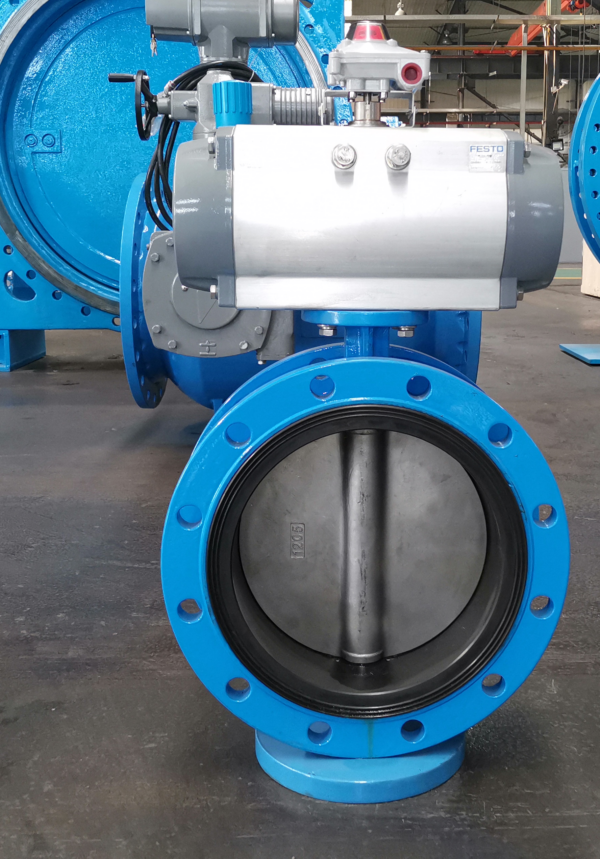The flow coefficient (Cv) of a butterfly valve is a numerical value that represents the valve’s capacity to allow fluid flow. It indicates the amount of flow that can pass through the valve at a specified pressure drop.
The Cv value is determined through testing and calculations based on industry standards, such as the American Society of Mechanical Engineers (ASME) standard. The process involves measuring the flow rate through the valve at various pressure differentials and then using the measured data to calculate the Cv value.
To determine the Cv value, the following steps are typically followed:
Setup and Measurement: The butterfly valve is installed in a test system, and the flow rate of fluid passing through the valve is measured. This is done by using flow meters or other measuring devices.
Pressure Differential: The pressure drop across the valve is measured by comparing the pressure upstream (inlet) of the valve to the pressure downstream (outlet) of the valve.
Data Collection: The flow rate and pressure differential data are collected at various points to cover a range of operating conditions.
Calculation: Using the collected data, the Cv value is calculated using the appropriate formula or equation. The calculation takes into account the measured flow rate, pressure differential, and fluid properties.
The Cv value is dimensionless and represents the flow capacity of the valve. A higher Cv value indicates a larger flow capacity, meaning the valve allows a greater volume of fluid to pass through at a given pressure drop. Conversely, a lower Cv value indicates a smaller flow capacity.
The Cv value is essential for engineers and designers when selecting and sizing valves for specific applications. It helps determine whether a particular butterfly valve is suitable for achieving the desired flow rate and pressure drop in a given system. Additionally, the Cv value can be used for comparing and selecting valves among different manufacturers or models.
What are the considerations for selecting the appropriate butterfly valve for a specific application?
When selecting the appropriate butterfly valve for a specific application, several considerations should be taken into account. These include:
Flow Requirements: Determine the desired flow rate and pressure drop for the application. Consider factors such as maximum and minimum flow rates, flow characteristics (steady-state or pulsating), and the permissible pressure drop across the valve.
Valve Size: Select the appropriate valve size based on the pipe diameter and desired flow capacity. Consider the flow velocity and ensure that the valve size can handle the expected flow rates without excessive pressure drop or flow restrictions.
Operating Conditions: Evaluate the operating conditions of the application, including the temperature, pressure, and fluid characteristics (such as viscosity, corrosiveness, and cleanliness). Ensure that the selected butterfly valve is compatible with these conditions and can withstand them without compromising its performance or integrity.
Valve Type and Design: Consider the specific requirements of the application and select the appropriate butterfly valve type and design. Common types include concentric, double-offset, and triple-offset valves, each offering different flow characteristics, pressure ratings, and sealing capabilities.
Valve Material: Choose a valve material that is compatible with the fluid being handled and the operating conditions. electric pneumatic butterfly valves Consider factors such as corrosion resistance, chemical compatibility, and temperature limitations. Common materials include stainless steel, cast iron, PVC, and various alloys.
Sealing and Leakage Requirements: Determine the required sealing performance for the application. Consider whether the valve needs to provide bubble-tight shutoff or if a certain level of leakage is acceptable. This will influence the choice of sealing materials, such as elastomers or metal seals.
Actuation and Control: Determine if the butterfly valve needs to be manually operated or if it requires automated actuation. Consider the control system requirements, such as on/off operation or modulating control, and select the appropriate actuator type (electric, pneumatic, hydraulic) if automation is necessary.
Standards and Certifications: Ensure that the selected butterfly valve complies with relevant industry standards and certifications. This ensures that the valve meets certain quality, performance, and safety requirements. Examples of standards include API, ANSI, ISO, and specific industry certifications.
Maintenance and Serviceability: Consider the ease of maintenance, repair, and replacement of parts for the selected valve. Evaluate factors such as accessibility, availability of spare parts, and the manufacturer’s reputation for product support.
Cost and Budget: Consider the overall cost of the butterfly valve, including the initial purchase, installation, and ongoing maintenance expenses. Balance the desired features and performance against the available budget.
By carefully considering these factors, you can select the most suitable butterfly valve for your specific application, ensuring optimal performance, reliability, and longevity. Consulting with valve manufacturers, industry experts, or professional engineers can provide additional guidance and assistance in the selection process.
